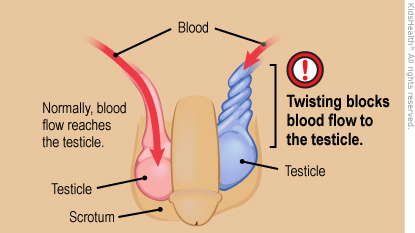Intermittent Testicular Torsion: How to Care for Your Child
When a boy has testicular torsion, one of his testicles twists inside the scrotum. This twisting blocks blood flow to the testicle and if it's not treated right away, can cause permanent damage. Sometimes a testicle twists and untwists on its own before any damage happens — this is called intermittent testicular torsion. Testicular torsion is a medical emergency, so if it seems like the torsion is happening again, go to the emergency room right away. Don't wait to see if the torsion goes away on its own.


-
Your son should take a break from sports and exercise until the surgeon says it's OK.
-
Don't give your son ibuprofen, acetaminophen, or other pain relievers until the surgeon says it's OK. They can mask the pain that signals the torsion may be happening again.
-
Make sure your son knows to tell you or another adult if he has:
-
Let caregivers, teachers, and coaches know about your son's condition. Tell them to get emergency care if your son has pain in the scrotum or lower belly.
-
Make any follow-up appointments as directed.


Your son has:
-
pain in the scrotum, groin, or lower belly
-
nausea or vomiting
-
a swollen or reddish scrotum

What is intermittent testicular torsion? Intermittent testicular torsion is when a testicle twists inside the scrotum and then returns to its normal position on its own. When a testicle twists and then untwists, there's a good chance it may twist again — and stay that way. If the testicle stays twisted, blood supply to it gets blocked and can cause permanent damage.
Some boys are born with a condition called bell clapper deformity that makes the testicles more likely to twist because they're not attached normally to the scrotum.
How does a health care provider diagnose testicular torsion? At the emergency room, health care providers ask questions and do an exam. They might order a urine test and a painless test called an ultrasound to look at blood flow to the testicles.
How is testicular torsion treated? A surgeon does an emergency operation to untwist the testicle and get blood flowing to the testicle again. If the testicle is healthy, the surgeon will attach it to the scrotum to help prevent it from twisting again. If the testicle was twisted for too many hours, it might be too damaged and need to be removed.
How is intermittent testicular torsion treated? If a boy has an intermittent torsion, a surgeon will schedule an operation to attach the testicles to the scrotum to help prevent them from twisting in the future. This minor surgery can help prevent damage to the testicles.